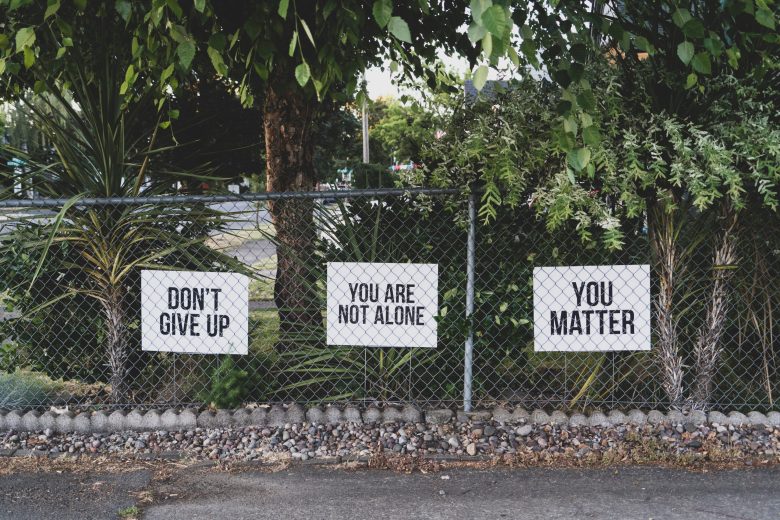By Anissa Durham,
Word in Black
Whether you’ve ever experienced suicidal ideations or talked about it — Black folks are suffering in silence. But it doesn’t have to be that way.
Feelings of sadness and hopelessness are common in the Black community. Some people may experience suicidal ideation, which means wanting to take your own life or thinking about suicide. A recent report by the Centers for Disease Control and Prevention’s National Center for Health Statistics shows that between 2016 and 2020, Black people went to the emergency room due to suicidal ideation more than any other group.
With professional mental health support typically dependent on health insurance, seeing a therapist may seem out of reach. Oftentimes, whether young or old, only 12.5 percent of Black folks said they felt comfortable talking to family and friends about their mental health. However, if support is not always available, social media and online support is usually what people turn to.
But the way journalists report on suicidal ideations and death by suicide — particularly when a journalist may lack connection to or empathy for Black folks — can impact readers’ mental health and the way they view suicidal thoughts.
Whether you’ve ever experienced suicidal ideations or talked about it — Black folks are suffering in silence. But it doesn’t have to be that way.
Feelings of sadness and hopelessness are common in the Black community. Some people may experience suicidal ideation, which means wanting to take your own life or thinking about suicide. A recent report by the Centers for Disease Control and Prevention’s National Center for Health Statistics shows that between 2016 and 2020, Black people went to the emergency room due to suicidal ideation more than any other group.
With professional mental health support typically dependent on health insurance, seeing a therapist may seem out of reach. Oftentimes, whether young or old, only 12.5 percent of Black folks said they felt comfortable talking to family and friends about their mental health. However, if support is not always available, social media and online support is usually what people turn to.
But the way journalists report on suicidal ideations and death by suicide — particularly when a journalist may lack connection to or empathy for Black folks — can impact readers’ mental health and the way they view suicidal thoughts.
Dr. Jill Harkavy-Friedman, senior vice president of research at the American Foundation for Suicide Prevention, says in an email interview that the media plays an important role in reducing the stigma of suicide through respectful reporting — “suicide is a public health issue.”
According to the CDC, more than 12 million people experienced suicidal thoughts in 2021. With 3.5 million people making a plan for suicide. Whether you realize it or not, most people have been affected by or have experienced suicidal ideation and behavior.
Stigma plays a big part in how Black people view and talk about suicidal ideation. The mentality to push through difficult emotions and to be resilient — although understandable — is not always helpful and can delay the help someone needs. To break the cycle of stigma, Black folks are working to have tough conversations and push each other toward healing.
That makes it even more necessary for journalists to learn best practices on reporting suicidal ideation and behavior with a lens of intention and mindfulness. And, readers need to know what to do when they come across triggering content.
As a reporter, I constantly have to balance my coverage by stating the facts and normalizing the mental health experiences folks have — while being mindful that how I talk about suicide can influence the health outcomes of those who are at risk.
Suicide is a heavy and complex topic. As a reader, it is OK not to read articles that include this type of content. But, if you do decide to read about triggering topics like suicide, a GoodRx Health article details a few helpful tips.
First, know your triggers. Certain words may bring up painful memories or remind you of a traumatic experience. Second, give yourself some space. If you are reading an article or viewing content that becomes too uncomfortable, take a break, go for a walk, or simply close out the material. And remind yourself that it’s normal to feel unsettled. This can help validate your feelings and past experiences.
Power of storytelling
Reading stories on suicide can actually help reduce suicidal ideations. Peter J. Franz, one of the lead researchers on a 2022 study told the Psychiatric Times, “It takes 10 minutes or less each day to read a story, yet digital narrative-based bibliotherapy makes a measurable difference, which may have a protective effect against suicidal thoughts and behaviors.”
According to the American Foundation for Suicide Prevention, 48,183 Americans died by suicide in 2021, whereas 1.7 million survived a suicide attempt. The ratio shows that more people survive a suicide attempt than die from one.
“We don’t hear or read enough stories around healing from a suicide attempt,” says Harkavy-Friedman, “and it’s important to include the perspective of people with lived experience to show that there is hope and those who are struggling are not alone.”
If you are ever contacted by a journalist or reach out to one — know that you are the keeper of your own story. This means, do not ever feel pressured to share information about yourself that you are not comfortable with, especially about suicidal ideation and attempts.
But, there is power in storytelling. Some notable examples reported on by Word In Black, include the experiences of Abraham Sculley, Shamari White, and Teresa Akintonwa. Each shared their individual struggles battling suicidal ideation due to experiencing major depression, hypersexualization, and COVID-19.
Their stories span different generations and illuminate the power of speaking up. They openly shared some of their darkest moments, but a thread throughout was how they survived and healed. This reminds readers that dealing with mental health woes can be temporary.
“In fact, 90-95 percent of people who survive a suicide attempt, go on to live their lives,” Harkavy-Friedman says. “By including this message and sharing the stories of survivors of suicide attempts, we can reach those who may be struggling and reassure them that they are not alone and there is help and support out there.”
Best practices for reporters
A few years ago, Poynter published an article on best practices for covering suicide responsibly. Some of the best practices — which Word In Black adheres to — are not stating the means of death, including quotes from suicide prevention experts, and providing a message of hope and resources for readers.
AFSP expands on that with a list of tips for reporting on suicide. A few tips from that list include, not referring to a suicide attempt as “successful” or “unsuccessful,” informing readers without sensationalizing the suicide, and not using the word suicide in the headline of a story.
“By reporting about suicide openly and safely, we are helping to strip away the shame that often comes with mental health issues or suicidal ideation and normalizing talking about a topic that for too long was taboo,” says Harkavy-Friedman.
As reporters, we have a responsibility to inform the public — but we have to be mindful of the way we write so as not to cause harm to vulnerable people. If you or someone you know is struggling with suicidal ideation, there are resources available.
- American Foundation for Suicide Prevention provides a list of crisis services and additional resources to support LGBTQ folks and those in underrepresented communities.
- Call the 988 Suicide & Crisis Lifeline for 24/7 free and confidential support for people in distress.
- The Crisis Text Line provides free, 24/7, confidential support through text messages to people in crisis when they dial 741741.
This article was originally published by Word in Black.
The post The power of safe reporting on mental health appeared first on AFRO American Newspapers .











